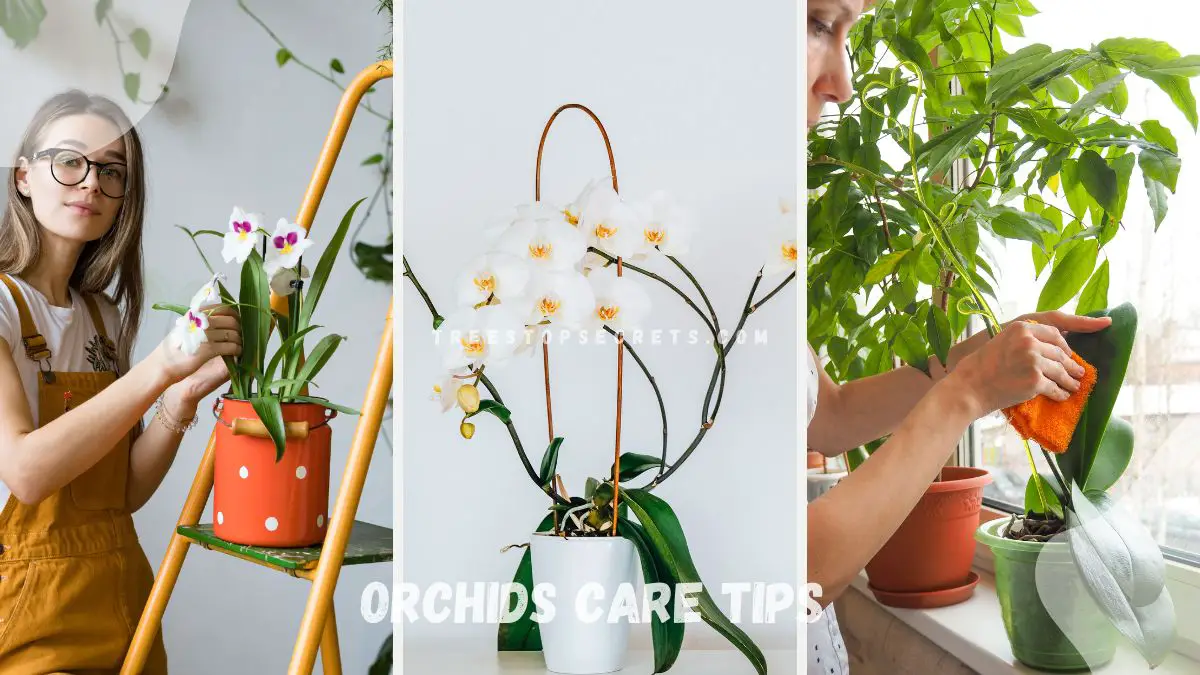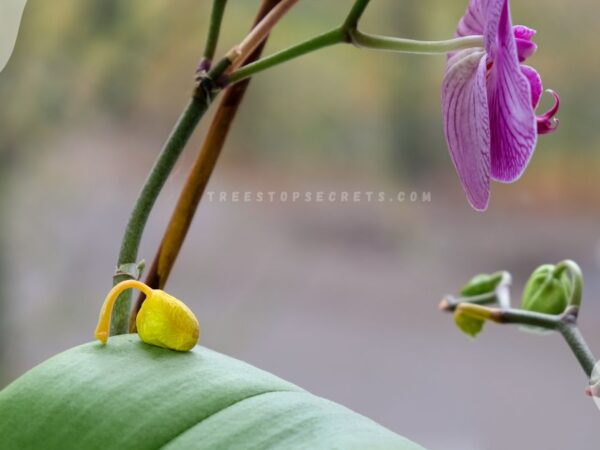Orchids can be a bit finicky, but with the right care tips, anyone can cultivate these elegant plants successfully. To keep your orchids thriving, focus on their unique needs for light, watering, humidity, and temperature. Understanding their natural environment can help replicate conditions that will ensure they flourish in your home or garden. I’m here to guide you through the process with practical, easy-to-follow advice, so you can enjoy the beauty of orchids without the guesswork. With these orchids care tips, you'll be on your way to growing healthy, vibrant orchids in no time.
To care for orchids effectively, follow these essential tips: Light: Place orchids in bright, indirect sunlight. Watering: Water once a week, allowing the soil to dry slightly between waterings. Humidity: Maintain humidity levels between 40-60%. Temperature: Keep them in temperatures between 65-80°F (18-27°C) during the day, and slightly cooler at night. Fertilizing: Use a balanced fertilizer every two weeks during the growing season. Repotting: Repot every 1-2 years using a well-draining orchid mix. Pests: Regularly check for pests like mealybugs and aphids, and treat them promptly. Adhering to these guidelines will help your orchids thrive.
| Aspect | Recommendation |
|---|---|
| Light | Bright, indirect sunlight |
| Watering | Weekly, allowing soil to dry slightly |
| Humidity | 40-60% |
| Temperature | 65-80°F (18-27°C) |
| Fertilizing | Every two weeks during growing season |
| Repotting | Every 1-2 years |
| Pests | Check regularly, treat promptly |
With these foundational tips, you're well-equipped to start your orchid care journey. For more advanced guidance and specific orchid species care, I have plenty more to share to help your orchids thrive year-round.
Key Takeaways
- Understand the key requirements for orchids to ensure their health and growth.
- Choose the right supplies tailored to your orchid's specific needs for optimal care.
- Create suitable growth environments by considering factors like light, temperature, and humidity.
- Implement practical care tips such as watering schedules and proper ventilation to maintain orchid health.
- Foster orchid blooming by providing adequate light, nutrients, and appropriate pruning when necessary.
- Address common care challenges promptly to prevent issues like pests or diseases from affecting your orchids.
Key Requirements for Orchids
When caring for healthy orchids, it is essential to understand the optimal orchid care requirements. Providing the right conditions ensures that your orchids thrive.
Watering Techniques
Watering is crucial for healthy orchid growth. Water orchids weekly to maintain proper moisture levels in the soil. Adjust the watering frequency based on the specific orchid type and the environment it's in. Using a well-draining orchid mix helps prevent waterlogging, which can lead to root rot.
Light and Temperature
Proper light and temperature are key factors in orchid care. Place your orchids in locations with suitable light intensity, ensuring they receive enough but not too much sunlight. Monitor light and temperature changes regularly to maintain optimal conditions for your orchids' health and growth.
Humidity and Air Flow
Maintaining the right humidity levels is vital for orchid growth. Provide adequate air circulation around your orchids to prevent fungal issues that can arise from stagnant air. Using humidity trays can help regulate moisture levels around your orchids, creating an environment that promotes healthy growth.
Choosing the Right Supplies
Best Orchid Mix
When caring for orchids, select a mix that promotes good drainage and aeration to prevent root rot. Different orchid varieties have specific requirements, so choose a mix that suits their needs. Opt for orchid mixes with organic components to ensure proper nutrient absorption.
Selecting Pots
When it comes to pots for your orchids, choose clear or white ones to easily monitor the health of the roots. Ensure the pots are appropriately sized to accommodate the orchid roots without leaving excess space. It's crucial to select pots with adequate drainage holes to avoid water accumulation, which can lead to root rot.
Fertilizer Types
For optimal growth, utilize specialized orchid fertilizers that provide balanced nutrition tailored to their needs. Follow a weakly weekly fertilizing schedule to ensure consistent nourishment for your orchids. Adjust the dosage of fertilizer based on the growth stages of your orchids for best results.
Orchid Growth Environments
Indoor Care
Creating suitable indoor environments for orchids is crucial for their growth. Protect them from drafts and sudden temperature changes to prevent stress. Monitor humidity levels indoors to replicate natural orchid habitats accurately.
Indoor orchids thrive in environments with stable temperatures and adequate light. Avoid placing them near vents or windows that can cause temperature fluctuations. Ensure proper ventilation to prevent stagnant air around the plants, promoting healthy growth.
Maintain consistent watering schedules to prevent overwatering or underwatering, which can harm orchids. Use well-draining potting mixtures to prevent waterlogging, ensuring the roots remain healthy. Consider using orchid starter kits for beginners to provide essential supplies for successful cultivation.
Outdoor Considerations
When considering outdoor environments for orchids, factors like sunlight exposure and protection from harsh weather conditions are vital. Choose a location with filtered sunlight to prevent sunburn on delicate orchid leaves. Shield them, hid from strong winds that can damage their fragile structures.
Ensure proper drainage in outdoor settings to avoid water accumulation around the roots, which can lead to root rot. Implement a regular fertilization schedule to provide essential nutrients for robust growth and vibrant blooms. Consider setting up a small greenhouse outdoors for controlled environmental conditions.
Practical Care Tips
Repotting Orchids
Repot orchids every two years to refresh the growing medium and provide adequate space for root growth. Use a pot with proper drainage holes to prevent waterlogging, leading to root rot. Ensure the new pot is only slightly larger than the previous one to avoid excessive moisture retention.
When repotting, gently remove the orchid from its current pot, trim any dead roots, and inspect for signs of disease or pests. Trim back overgrown roots to promote healthy growth and prevent overcrowding in the new pot. Place the orchid in fresh potting mix designed specifically for orchids, ensuring good aeration and drainage.
Pruning for Health
Regularly prune your orchids to maintain their health and encourage blooming. Remove dead or yellowing leaves to prevent the spread of disease and improve airflow around the plant. Trim spent flower spikes to redirect the plant's energy into new growth rather than seed production.
Prune orchids after they have finished blooming by cutting back the flower spike to just above a node where new growth can emerge. This process stimulates the plant to produce new flowers and promotes overall vitality. Avoid leaving stubs when pruning to prevent potential infections.
Treating Sick Orchids
Identify common signs of sick orchids such as yellowing leaves, stunted growth, moldy spots, or unusual discoloration. Isolate any sick plants to prevent the spread of disease to other orchids in your collection. Adjust watering habits if you notice signs of overwatering or underwatering.
Treat sick orchids by addressing the underlying issue causing distress. For example, if you suspect root rot due to overwatering, trim affected roots and repot the orchid in fresh, well-draining medium. Use appropriate fungicides or insecticides if pests or diseases are present, following manufacturer instructions carefully.
Orchid Blooming
Blooming is a crucial stage in an orchid's life cycle. Encouraging Re-Bloom requires proper care and attention to the plant's needs. Understanding the Bloom Frequency of different orchid varieties is essential for successful flower production.
Encouraging Re-Bloom
To encourage re-blooming, ensure your orchid receives adequate light. Place it in a location with indirect sunlight. Regular watering is key but avoid overwatering as it can lead to root rot. Use a well-draining orchid potting mix to prevent waterlogging.
- Provide proper ventilation to prevent fungal infections.
- Maintain consistent temperatures, ideally between 65-75°F during the day and slightly cooler at night.
- Fertilize your orchid regularly using a balanced orchid fertilizer to promote healthy growth and blooming.
Bloom Frequency
The bloom frequency of orchids varies depending on the species and growing conditions. Some orchids bloom once a year, while others can bloom multiple times annually. Understanding the bloom frequency of your specific orchid variety is crucial for effective care.
- Phalaenopsis orchids, also known as moth orchids, typically bloom once a year but can produce flowers that last for several months.
- Dendrobium orchids have varying bloom frequencies, with some species blooming once a year and others blooming multiple times throughout the year.
- Oncidium orchids, commonly referred to as dancing lady orchids, tend to bloom once or twice a year, producing vibrant and fragrant flowers.
Common Care Challenges
Addressing Problems
Taking care of orchids can sometimes be challenging, especially for beginners. One common issue is overwatering, which can lead to root rot and ultimately kill the plant. To prevent this, ensure that the orchid's pot has proper drainage holes.
Another challenge is providing the right amount of light. Orchids require indirect sunlight to thrive, so placing them in direct sunlight can cause sunburn on their leaves. To address this, consider using sheer curtains or placing the orchids near a window with indirect sunlight.
Maintaining the correct humidity levels can be tricky. Orchids prefer high humidity, but too much moisture can result in fungal diseases. To tackle this, use a humidity tray or a humidifier to create an ideal environment for your orchids.
To ensure healthy growth, it's essential to address pest infestations promptly. Common pests that affect orchids include aphids and spider mites. Regularly inspect your plants and treat any infestations with appropriate insecticides or natural remedies.
FAQ Insights
- Q: How often should I water my orchid?
- A: Watering frequency depends on factors like the type of orchid, potting medium, and environmental conditions. As a general rule, water your orchid when the top inch of the potting mix feels dry.
- Q: Why are my orchid leaves turning yellow?
- A: Yellowing leaves can be a sign of various issues such as overwatering, nutrient deficiencies, or inadequate light exposure. Assess your care routine and make adjustments accordingly.
- Q: How do I repot my orchid?
- A: Repotting is necessary when the orchid outgrows its current pot or when the potting medium breaks down. Choose a slightly larger pot with good drainage and fresh potting mix suitable for orchids.
- Q: What is the best temperature range for orchids?
- A: Most orchids thrive in temperatures between 60-80°F during the day and slightly cooler at night. Providing a moderate temperature fluctuation mimics their natural habitat conditions.
Remember, addressing these common challenges and being proactive in caring for your orchids will help them thrive and bloom beautifully.
Advanced Care Strategies
Diverse Orchid Needs
Orchids are a diverse group of plants with varying needs, including light, temperature, and humidity requirements. Understanding these diverse needs is crucial for successful orchid care.
- Some orchids thrive in bright, indirect light, while others prefer more shade.
- Certain species require specific temperature ranges to bloom and grow healthily.
- Humidity levels can also vary among different types of orchids, with some needing higher humidity than others.
Creating a custom care plan tailored to your orchid's specific needs is essential for promoting healthy growth and vibrant blooms. By identifying the unique requirements of your orchid, you can provide optimal conditions for its well-being.
Custom Care Plans
When developing a custom care plan for your orchid, consider factors such as the type of orchid, its natural habitat, and any specific care instructions provided by the grower or seller.
- Researching the specific needs of your orchid species can help you create a tailored care routine.
- Adjusting light exposure, watering frequency, and fertilization based on your orchid's requirements can promote robust growth.
- Monitoring your orchid's progress and making adjustments as needed is key to maintaining its health and vitality.
Customizing your care plan may involve experimenting with different growing conditions until you find the optimal balance for your orchid. Observing how your orchid responds to changes in care can help you fine-tune your approach for long-term success.
Closing Thoughts
In caring for your orchids, remember the key requirements, choose the right supplies, create suitable growth environments, implement practical care tips, understand blooming processes, tackle common challenges, and consider advanced care strategies. By following these steps diligently, you can ensure your orchids thrive and bloom beautifully. Remember, consistent care and attention are crucial for the well-being of your plants.
Now that you have a comprehensive understanding of orchid care tips, it's time to put your knowledge into action. Take the next step by applying these strategies to your own orchids. Share your successes and challenges with fellow enthusiasts to enhance your skills further. Your commitment will not only benefit your plants but also deepen your appreciation for these exquisite flowers.
Frequently Asked Questions
How do I choose the right supplies for my orchids?
When choosing supplies for your orchids, consider factors like the type of orchid, potting medium, fertilizer, and watering tools. Opt for high-quality materials to ensure proper growth and health of your orchids.
What are the key requirements for successful orchid care?
Successful orchid care requires attention to factors such as light, temperature, humidity levels, watering schedule, fertilization, and proper ventilation. Understanding these requirements is crucial for maintaining healthy and thriving orchids.
What are some practical care tips for beginner orchid enthusiasts?
For beginners, it's essential to start with easy-to-care-for orchid varieties, understand your orchid's specific needs, avoid overwatering, provide adequate light without direct sun exposure, maintain proper humidity levels, and repot when necessary to promote healthy growth.
How can I encourage my orchids to bloom successfully?
To encourage blooming in orchids, ensure they receive the right amount of light exposure, provide appropriate temperature conditions, adjust watering frequency during the blooming season, use a balanced fertilizer specifically for blooming plants, and maintain consistent care routines to support the flowering process.
What are some common care challenges faced by orchid growers?
Common care challenges include improper watering leading to root rot or dehydration, inadequate light causing stunted growth or lack of blooms, incorrect temperature levels affecting overall health, pests infestations like spider mites or aphids, and using the wrong type of fertilizer that can harm the plants.
Image Source: Paid image from CANVA





